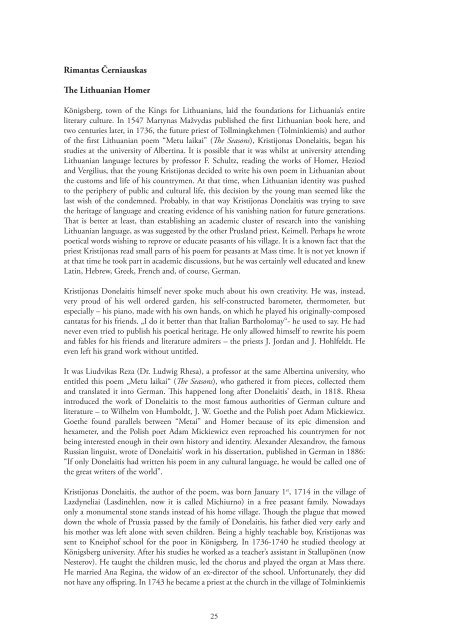BALTIC MEETINGS - Baltic Writers Council
BALTIC MEETINGS - Baltic Writers Council
BALTIC MEETINGS - Baltic Writers Council
Create successful ePaper yourself
Turn your PDF publications into a flip-book with our unique Google optimized e-Paper software.
Rimantas Černiauskas<br />
e Lithuanian Homer<br />
Königsberg, town of the Kings for Lithuanians, laid the foundations for Lithuania’s entire<br />
literary culture. In 1547 Martynas Mažvydas published the first Lithuanian book here, and<br />
two centuries later, in 1736, the future priest of Tollmingkehmen (Tolminkiemis) and author<br />
of the first Lithuanian poem “Metu laikai” (e Seasons), Kristijonas Donelaitis, began his<br />
studies at the university of Albertina. It is possible that it was whilst at university attending<br />
Lithuanian language lectures by professor F. Schultz, reading the works of Homer, Heziod<br />
and Vergilius, that the young Kristijonas decided to write his own poem in Lithuanian about<br />
the customs and life of his countrymen. At that time, when Lithuanian identity was pushed<br />
to the periphery of public and cultural life, this decision by the young man seemed like the<br />
last wish of the condemned. Probably, in that way Kristijonas Donelaitis was trying to save<br />
the heritage of language and creating evidence of his vanishing nation for future generations.<br />
at is better at least, than establishing an academic cluster of research into the vanishing<br />
Lithuanian language, as was suggested by the other Prusland priest, Keimell. Perhaps he wrote<br />
poetical words wishing to reprove or educate peasants of his village. It is a known fact that the<br />
priest Kristijonas read small parts of his poem for peasants at Mass time. It is not yet known if<br />
at that time he took part in academic discussions, but he was certainly well educated and knew<br />
Latin, Hebrew, Greek, French and, of course, German.<br />
Kristijonas Donelaitis himself never spoke much about his own creativity. He was, instead,<br />
very proud of his well ordered garden, his self-constructed barometer, thermometer, but<br />
especially – his piano, made with his own hands, on which he played his originally-composed<br />
cantatas for his friends. „I do it better than that Italian Bartholomay“- he used to say. He had<br />
never even tried to publish his poetical heritage. He only allowed himself to rewrite his poem<br />
and fables for his friends and literature admirers – the priests J. Jordan and J. Hohlfeldt. He<br />
even left his grand work without untitled.<br />
It was Liudvikas Reza (Dr. Ludwig Rhesa), a professor at the same Albertina university, who<br />
entitled this poem „Metu laikai“ (e Seasons), who gathered it from pieces, collected them<br />
and translated it into German. is happened long after Donelaitis’ death, in 1818. Rhesa<br />
introduced the work of Donelaitis to the most famous authorities of German culture and<br />
literature – to Wilhelm von Humboldt, J. W. Goethe and the Polish poet Adam Mickiewicz.<br />
Goethe found parallels between “Metai” and Homer because of its epic dimension and<br />
hexameter, and the Polish poet Adam Mickiewicz even reproached his countrymen for not<br />
being interested enough in their own history and identity. Alexander Alexandrov, the famous<br />
Russian linguist, wrote of Donelaitis’ work in his dissertation, published in German in 1886:<br />
“If only Donelaitis had written his poem in any cultural language, he would be called one of<br />
the great writers of the world”.<br />
Kristijonas Donelaitis, the author of the poem, was born January 1 st , 1714 in the village of<br />
Lazdyneliai (Lasdinehlen, now it is called Michiurno) in a free peasant family. Nowadays<br />
only a monumental stone stands instead of his home village. ough the plague that mowed<br />
down the whole of Prussia passed by the family of Donelaitis, his father died very early and<br />
his mother was left alone with seven children. Being a highly teachable boy, Kristijonas was<br />
sent to Kneiphof school for the poor in Königsberg. In 1736-1740 he studied theology at<br />
Königsberg university. After his studies he worked as a teacher’s assistant in Stallupönen (now<br />
Nesterov). He taught the children music, led the chorus and played the organ at Mass there.<br />
He married Ana Regina, the widow of an ex-director of the school. Unfortunately, they did<br />
not have any offspring. In 1743 he became a priest at the church in the village of Tolminkiemis<br />
25


